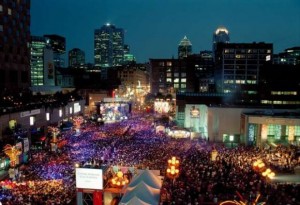The quaintly-named Quartier des Spectacles is a 250-acre entertainment district in downtown Montreal, currently one of the largest urban redevelopment project in a North American City. Unlike 1960s urban renewal, the apparent centerpiece is not low-income housing or office towers but arts and entertainment. The Quartier includes the Museum of Contemporary Art, the National Theatre School of Canada, and many existing performance halls, as well as outdoor spaces for the now dozens of festivals that have made Montreal a world leader in the visual and performing arts. The recently-built Bibliothèqe Nationale, a rather cheerless glass box, anchors one end, and Montreal’s version of Lincoln Center, the other. The Quartier, was a previously run-down section of downtown, which is precisely why many small theater and performing arts companies sprang up there. So, an arts project? Not exactly. The $120 million of public funds is expected to generate $1.9 billion in private investments, mostly presumably in retail, commercial and residential development. Real estate investors will end up calling the shots, and it would be surprising if the result will not be a sanitized, branded, high-design version of a bohemian arts district. Times Square with an accent.
On Culture and Architecture


Montreal survives and thrives despite what has been done to it. The horror of the Decarie Expressway, Dorchester Boulevard, the Metropolitan Expressway and many other “grand projets” sliced through neighborhoods, taking many fine buildings with them, to say nothing of the rending of the social fabric of the city.
I know the city from it’s very foundations. My grandfather worked for the city as an engineer…eventually being charged with its water supply and its sewage. At a young child, I knew where the water was acquired from the St. Lawrence and the pumping stations in Youville Sq…the reservoirs on the Mountain and the pumping station in Chateauguay. I know where Dickens St. used to be…and the outlines of the ancient city walls….and how the architect of Notre Dame sloped its floor to improve sight lines. I can remember what the harbor looked like before the Seaway was constructed and the history of Bonsecours church…and the history of Grosse Isles and the thousand still buried beneath Dominion Sqare.
Through all of this, Montreal bustles with fashionable women and the happy mixture of languages and customs. Franglais abounds with a thin soupçon of Arabic and Cantonese and the brough accents of Calabria.
The unusual broth of architecture along the length of Sherbooke, from triplexes to elegant townhouses. The still raw and rude constructions of the 60’s and the High Street running through Westmount and NDG…terminating in the lovely Tudor Gothic of Loyola. I know all of it, inch by inch with a firm recollection of where the greengrocer used to be and Macwhinnies bicycle shop and venerable Murray’s Tea Room
A great memory of a great city. One of Montreal’s distinguishing characteristics, as Daniel Bell and Avner de Shalit’s upcoming “The Spirit of Cities,” argues, is the interplay of languages, historically French and English, but originally French and Iroquois, and recently many other tongues–Yiddish, Hungarian, Vietnamese, and Haitian patois. Curiously, one of the Gallic impulses that makes Montreal interesting also makes it frustrating–the need for the grand civic gesture. It produced Mount Royal park and the renovation of Old Montreal, but also white elephants such as Mirabel airport and the Olympic stadium. And maybe the Quartier des Spectacles?